


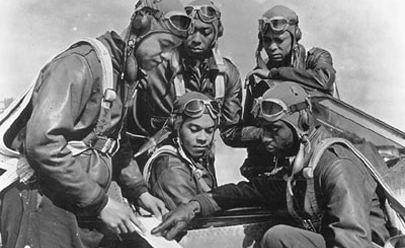
The African American Story Part 5 (African Americans in World War II)
During World War II, it was a national and international affair. Nations formed alliances to fight for the power of the Earth's resources during World War II. Black Americans were in the middle of the global conflict. Many of our people were drafted into that war. That is why many of our grandparents and great-grandparents participated in World War II. Segregated units would fight in the battles. Black people fought fascism overseas and against racism at home. So, WWII signified battling multiple battles domestically and outside America. Over 2.5 million black men registered for the draft and many served as draftees or volunteers in all of the branches of the Armed Forces during the war. Black men and Black women fought with distinction. In fact, more than 12,000 black men, who served in the 92nd Division, received citations and were decorated for their effort. The all-black 761st Tank Battalion received the Presidential Unit Citation for “extraordinary heroism.” Also, black women were involved in WWII too. Many black women were in the military including nurses. Their heroism will be mentioned here too. Many African American G.I.s were in concentration camps and many black people were victims of the evil Holocaust (which was about the Nazis' evil action of the extermination of millions of human beings). Many labor strikes existed (among workers of diverse colors) to fight for workers' rights during this time period. There was a class struggle for economic justice back then. Racial riots happened nationwide during the 1940's from Detroit to Chicago. Hollywood grew. Jazz grew and the Second Great Migration flourished during this time period as well. The Tuskegee Airmen helped to defeat the Axis Powers and numerous World War II (including Korean War) veterans would go onward to be part of the Civil Rights movement. WWII and its aftermath ironically propelled a new inspiration to make the Civil Rights movement to achieve more successes. World War II was a long, very bloody war. It was destructive and took more human lives than any other war in human history. War shouldn't be sugarcoated. We honor the sacrifice of heroes who defeated fascism. We are motivated to fight for justice in our time during the 21st century.
Still, we rise.
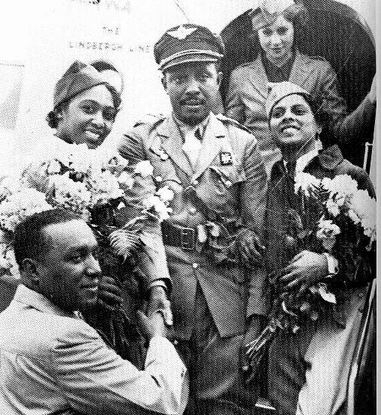

The Beginning and Black Units
From the beginning, African Americans (both black men and black women) fought in every American war. African Americans back then knew of the contradiction of fighting for freedom overseas while being unjustly denied freedom at home in the United States of America. In this situation, African Americans have shown courage and strength. Before World War II, black Americans fought against fascists in Ethiopia and against the Fascists plus the Nazis in Spain during the 1930’s. The U.S. government didn’t fight Italy or fascists invading Ethiopia, but African Americans did so independently in order for them to defend freedom. Back during October 4, 1935, fascist Italy invaded Ethiopia. Ethiopia was the only non-colonized African country at that time other than Liberia. So, African Americans were inspired to defend Ethiopia. This was personal for us. Black people raised money for medical supplies and many volunteered to fight for the nation. Ethiopia at first was overpowered by the Italian forces using mustard gas and other advanced weaponry. Yet, Ethiopia soon defeated the Italians years later. Many years later, Haile Selassie I would comment on the efforts of black Americans:
"We can never forget the help Ethiopia received from Negro Americans during the crisis. ... It moved me to know that Americans of African descent did not abandon their embattled brothers, but stood by us.”
The Spanish Civil War was about the fascist Franco and his forces fighting against the pro-Republican forces of the secular Spanish Republic. Many African Americans volunteered to fight for the Republican Spain. Many black Americans had Communist ideals while serving in the Abraham Lincoln Brigade. Many black people like Vaughn Love had rightfully said that fascism is the enemy of all “black aspirations.” Oliver Law was an African American activist and World War I veteran who also fought in the Abraham Lincoln Brigade during the Spanish Civil War too. He is believed to be the first African American officer to command an integrated unit of soldiers. James Peck fought against the fascists in Spain. He was a black man. He was a pilot in the Spanish Republican Air Force. He shot down fascist airplanes. A black woman named Salaria Kea was a young African American nurse from Harlem Hospital who served during the Spanish Civil War too. She was one of the two only African American female volunteers in the midst of the war-torn Spanish Republican areas. When Salaria came back from Spain she wrote the pamphlet "A Negro Nurse in Spain" and tried to raise funds for the beleaguered Spanish Republic. We honor the bravery and sacrifice of these heroic black men and black women. Now, we focus on World War II.
After World War I, the League of Nations existed. It failed, because of many reasons. Many nations refused to abide by its rules and regulations. Its rules were weakly enforced. There was the rise of Hitler and Stalin who advanced authoritarian regimes. Japan also used imperialist aggression against China and other Asian countries. By 1939, Hitler invaded Poland unjustly and illegally, which started World War II. WWII was the bloodiest and most deadly war in human history. More people died during WWII than any other war in human history. Hitler was an evil racist, a liar, and a murderer. He and his Nazis used imperialism for the sake of stealing mineral resources, to promote genocide, to advance racism, and to form an evil worldwide empire. Hitler, Franco, Mussolini, and Tojo united into the nefarious Axis Powers. They spread their evil worldwide. In America, most Americans back then were isolationists. Most Americans didn’t want to be involved in another war, because of the destructiveness of WWI and their view of promoting solely focusing on American affairs. Recent research has found that some Americans knew of the Holocaust and still was hesitant in condemning the Holocaust (which is disgraceful). Pearl Harbor changed everything. Japan attacked American military forces on December 7, 1941.

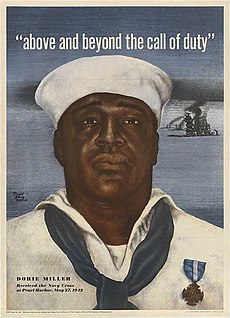
Many Americans died. There were many heroes during that deadly day. One hero was a black man named Doris Miller. He was a Navy mess attendant. He had voluntarily manned an anti-aircraft gun and fired at the Japanese anti-aircraft, despite of him having no prior training in the weapons’ use. He saved many lives. Later, Admiral Chester W. Nimitz pinned the Navy Cross on Doris Miller at a ceremony on board a warship in Pearl Harbor, Hawaii. This happened on May 27, 1942. He was the first black American to receive the Navy Cross because of his actions during the Pearl Harbor attack. Immediately, America declared war against Nazi Germany. The world soon changed and Franklin Delano Roosevelt overnight was overly involved in WWII (previously, he was covertly involved via the Lend Lease program where American forces would send money and supplies to Allied forces like those of the UK). By this time, the war was in the beginning. After the Pearl Harbor incident, the majority of Americans supported American involvement in World War II. Many black Americans hoped that defeating fascism overseas would defeat fascism and racism at home in America. Many black people opposed the draft, went to jail for rejecting the draft, etc. The journey of World War II for African Americans would change the world forever.

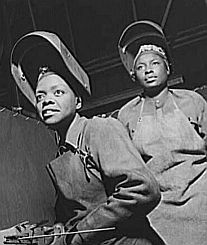
Discrimination
Over 1.9 million black Americans served in uniform during World War II. They served in segregated units. About 75 percent of the soldiers who served in the European theater of the war as truckers for the Red Ball Express and kept Allied supply lines open were African Americans. 708 African Americans were killed in combat during World War II. By June of 1940, the Navy had 4,007 African American personnel. That represented 2.3 percent of its total strength of nearly 170,000. One month after Pearl Harbor, African Americans being in the Navy were 5,026. Back then, many were restricted to work as steward’s mates. This changed slowly. The destroyer escort Mason was the only Navy vessel during World War II with a totally black crew who were not cooks or waiters. In 1995, 11 surviving crew members were all given belated recognition and letters of commendation from Navy Secretary John Dalton for having braved harsh weather and quickly welding the cracks in their ship so they could continue escorting support ships to England. The draft existed and there was a high enlistment rate in the U.S. Army for African Americans. African Americans also served in all branches of the American military. There was still massive discrimination and racism in the military. During the early part of the war, most African Americans never saw combat and most were not in the position that was high up in the military. Black women and Black men, who were in the military, were segregated at church services, in transportation and canteens, in barracks, and even in parades. Black men suffered such bad treatment in many cases that African American soldiers in many cases were treated worse than German prisoners of war.
That is a disgrace. Black women were given separate training, bad living quarters, and rations. Black nurses suffered both racism and sexism. They still cared for wounded soldiers and served magnificently. Soldiers of color including black soldiers served their country with distinction during World War II. About 125,000 African Americans were overseas in World War II. There were many segregated units. Many of them included the Tuskegee Airmen, the 761st Tank Battalion, and the 452nd Anti-Aircraft Artillery Battalion. They performed greatly in combat situations. Native Americans and Asian American suffered racism and discrimination in the military too. Asian Americans were integrated with European American soldiers. The first Chinese American USMC (or Marine) officer was Wilbur Carl Sze. He was commissioned as second lieutenant in December of 1943. Native Americans in many cases served as code talkers to pass coded messages throughout the military during World War II. This story is shown in a movie I saw back in 2002 called Windtalkers. Black people were not accepted into the Marines until 1942.
During World War II, like in previous eras, racial tensions were extremely high. Many black people excelled in jazz and other economic endeavors, but the system of oppression still existed in America. Racial riots and racial violence existed in Detroit, Mobile (Alabama), Chicago, Philadelphia, and other places nationwide during the 1940’s. During World War II, a lot of African Americans worked in industrial jobs. Many racists falsely accused black people of stealing jobs and placed black people as scapegoats for labor and economic issues. There were many immigrants in Northern and Midwestern plus Western cities who had such jobs too. Many resources were scarce and competition for resources intensified. Racial riots were the harshest during this era in Detroit during 1943. In June 20, 1943, black people and white people were found in the Belle Isle Park to escape the summer heat. Later, fights between black people and white people existed. It spread into widespread riots over false rumors of rape and murder. Later, white people with the aid of the police came into Detroit African American neighborhoods to attack black people at random. Mobs surrounded streetcars in Detroit to beat up innocent black people. 2 days later, 25 black people and 9 white people were killed. In June 15, rioting happened in Beaumont, Texas. A white woman accused a black man of raping her. Then, white racists destroyed homes, restaurants, and other buildings in black neighborhoods.
Over 100 homes were destroyed. The mayor caused the city to be under martial law with the help of the Texas National Guard. In Harlem in 1943, there was a rebellion of black people who were tired of racism, police brutality, and discrimination. This was after a white police officer in NYC injured an African American whom he arrested. In May 23, 1946, black workers in Mobile, Alabama were assaulted by white racists. These black workers just wanted to work in the Alabama Dry Dock and Shipbuilding Company in Mobile, Alabama. The FEPC wanted the plant to desegregate the workforce in Alabama. There were the rioting in Los Angeles (during the 1940’s) where racists assaulted Latino Americans with zoot suits especially, black people, Filipinos, and others (which was called the Zoot Suit Riots). This happened in June of 1943 in Los Angeles, California. The riot appeared to trigger similar attacks that year by whites against Latinos in Chicago, San Diego, Oakland, Evansville (in Indiana), Philadelphia, and New York City. In 1946, police and other authorities shot at windows and destroyed the property of innocent black people in Columbia, Tennessee.
There were blue discharges during World War II as well. This was another form of discrimination against African American soldiers. Blue discharges were discharges from the military without honor. It wasn’t honorable. It wasn’t dishonorable. It was equivalent to being fired from the military. Black troops disproportionately experienced blue discharges during WWII. They were created in 1916. 48,603 blue discharges were issued by the Army from December 1, 1941 to June 30, 1945. 10,806 were issued to African Americans. This accounts for 22.2% of all blue discharges, when African Americans made up 6.5% of the Army in that time frame. Blue discharge recipients had faced many difficulties obtaining employment. They were routinely denied the benefits of the G.I. Bill by the Veterans Administration (VA). By October 1945, Black-interest newspaper The Pittsburgh Courier launched a crusade against the discharge and its abuses. Calling the discharge "a vicious instrument that should not be perpetrated against the American Soldier", the Courier rebuked the Army for "allowing prejudiced officers to use it as a means of punishing Negro soldiers who do not like specifically unbearable conditions.” The Courier printed instructions on how to appeal a blue discharge and warned its readers not to quickly accept a blue ticket out of the service because of the negative effect it would likely have on their lives. The House Committee on Military Affairs held hearings in response to the press crusade, issuing a report in 1946 that sharply criticized its use and the VA for discriminating against blue discharge holders. Congress discontinued the blue discharge in 1947, but the VA continued its practice of denying G. I. Bill benefits to blue-tickets.
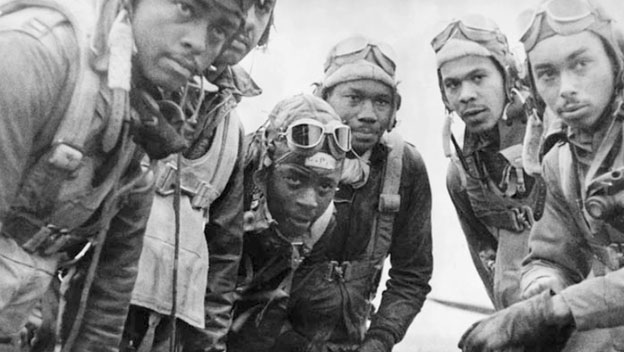

The Tuskegee Airmen
Courage and sacrifice define the Tuskegee Airmen. They were a group of military pilots who fought during World War II. They were active in the military throughout the 1940's. The Tuskegee program officially started on June 1941 with the 99th Pursuit Squadron at Tuskegee University. It had a unit of 47 officials and 429 enlisted men. One leader of the Tuskegee Airmen was Captain Benjamin O. Davis Jr. (who was the commander of the Tuskegee Airmen 332nd Fighter Group. He flew his P-47 Thunderbolt in Sicily). These men experienced racism and oppression, but they performed magnificently during the war. Mary McLeod Bethune and so many unsung heroes advanced the program to cause the Tuskegee Airmen to exist. Walter White of the NAACP, A. Philip Randolph, and Judge William H. Hastie wanted black men to be military aviators. So, in 1939, the federal government sent money to fund civilian flight schools to train African Americans. The Civilian Pilot Training Program allowed African Americans from colleges and universities to join the Tuskegee Airmen movement. Tuskegee Institute allowed many members to fly as well. The first class of black pilot prepared to do so in July 19, 1941. They were trained rigorously. They studied flying, navigation and meteorology. The first African Americans to get their silver wings and graduate was on the date of March 7, 1942. The Tuskegee Army Base was segregated and had many black pilots. The Tuskegee Airmen were in 9 different squadrons like the 332nd Fighter Group, the 99th, 100th, 301th, 302nd Fighter Squadrons, and the 616th, 617th, 618th, and 619th Bombardment Squadrons (they flew medium two engine bombers). When the pilots of the 332nd Fighter Group painted the tails of their P-47s and later, P-51s, red, the nickname "Red Tails" was coined. The red markings that distinguished the Tuskegee Airmen included red bands on the noses of P-51s as well as a red rudder; the P-51B and D Mustangs flew with similar color schemes, with red propeller spinners, yellow wing bands and all-red tail surfaces. Many of them were navigators, bombardiers, mechanics, instructors, crew chiefs, nurses, cooks, and other supporters of pilots. All black military pilots trained near Tuskegee Alabama at Moton Field in the Tuskegee Army Air Field. Jim Crow existed, so they were segregated.


The Tuskegee program was a successful endeavor and even First Lady Eleanor Roosevelt flew with the African American chief civilian instructor C. Alfred “Chief” Anderson on March of 1941. Anderson flew since 1929. Eleanor Roosevelt gave a loan to help build Moton Field. The loan was of $175,000. The 99th Squadron was involved in combat in April of 1943. They attacked an island on the Mediterranean Sea to clear lanes for the Allied invasion of Sicily in July 1943. By June 2, the combat mission was flown by the 99th. They moved into Sicily. They received a Distinguished Unit Citation for its actions in combat. Many of the Tuskegee Airmen were used as convoys to protect aircraft. Many of them shot down many Nazi aircraft including jets throughout Europe from France to Italy. The 332nd flew missions in Sicily, Anzio, Normandy, the Rhineland, the Po Valley and Rome-Arno and other places. Pilots of the 99th once set a record for destroying five enemy aircraft in less than four minutes. The Tuskegee Airmen shot down three German jets in a single day. In all, 992 pilots were trained in Tuskegee from 1941-46. 355 were deployed overseas, and 84 lost their lives in accidents or combat.
On March 24, 1945, the 332nd were involved in the longest bomber escort mission of the war. They shot down three of the new German ME-262 jet fighters and damaged 5 others without losing any of their own bombers or planes. The Tuskegee Airmen included some of the best pilots of the war. After the war in 1949, the 332nd Fighter Wing took first place in a shooting competition. It took place in Las Vegas, Nevada. The pilots were Capt. Alva Temple, Lts. Harry Stewart, James Harvey III and Herbert Alexander. Lt. Harvey said, "We had a perfect score. Three missions, two bombs per plane. We didn't guess at anything, we were good." They received congratulations from the Governor of Ohio, and Air Force commanders across the nation. Many famous Tuskegee Airmen included Edward C. Gleed of Lawrence, Kansas, Robert W. Williams, William H. Holloman, Ronald W. Reeves, Christopher W. Newman, Edward A. Gibbs, General Daniel “Chappie” James Jr., Marion Rodgers, and Walter M. Downs. Many of them would later work in NORAD, NASA, etc. The Tuskegee Airmen’s actions definitely contributed to the ending of the segregation of the military by 1948 (via the Executive Order of President Harry S. Truman called E.O. 9981). The excellence of the Tuskegee Airmen will always be remembered.


Other Stories of Service
During the Battle of the Bulge (which was one of the last offensives of the Nazis and the Nazis were defeated) during December of 1944, General Eisenhower was very short of replacement troops for existing all-white companies. So, he made the decision to allow 2,000 black servicemen volunteers to serve in segregated platoons under the command of white lieutenants to replenish these companies. These platoons would serve with distinction and according to an Army survey in the summer of 1945, 84% were ranked "very well" and 16% were ranked "fairly well". No black platoon received a ranking of "poor" by those white officers or white soldiers that fought with them. Unfortunately, these platoons were often subject to racist treatment by white military units in occupied Germany and were quickly sent back to their old segregated units after the end of hostilities in Germany. Despite their protests, these brave African American soldiers ended the war in their old non-combat service units. Though largely forgotten after the war, the temporary experiment with black combat troops proved a success - a small, but important step toward permanent integration during the Korean War. A total of 708 African Americans were killed in combat during World War II. There is the picture of an African American Battery A of the 452nd AAA (or Anti-Aircraft Artillery) Battalion on November 9, 1945. In 1945, Frederick C. Branch became the first African-American United States Marine Corps officer. There is another picture of African American soldiers in Burma reading President Truman’s Proclamation of Victory in Europe on May 9, 1945. In 1965, Marcelite J. Harris (who was born in Houston, Texas) became the first female African American United States Air Force officer. On January 13, 1997, President Bill Clinton (in a White House ceremony) awarded the nation’s highest military honor, which is the Medal of Honor, to seven African American servicemen who had served during World War II.


Double V
The Double V campaign was one of the most important campaigns of World War II. The Double V movement was a slogan. Its meaning was that it wanted black Americans to fight for democracy abroad and in America in order for racism to end in the States. The V victory sign was a double meaning. People who endorsed the Double V campaign wanted victory against the Axis Powers (along with their evils of aggression, slavery, and tyranny) and another victory for African Americans in America. It first appeared in the African American newspaper called the Pittsburgh Courier on February 7, 1942. The slogan started in a response to the letter, “Should I Sacrifice to Live 'Half American?'" written by 26-year-old reader James G. Thompson (He was from Wichita, Kansas). Pitched as "Democracy – Double Victory, At Home - Abroad", the campaign highlighted the risks African Americans took while they fought in the military campaign against Axis powers while denied their rights as citizens within the United States. Victory over fascism and racism (the double victory) was promoted by black people and many non-black people too. The campaign wanted civil rights and to get more African Americans to be involved in the war effort too. The Courier newspaper received massive support in dealing with the Double V movement. Telegrams came in to promote the campaign as well. Movie starts, other celebrities, etc. in magazines, postcards, and newspapers endorse the Double V movement. The Double V campaign was eventually adopted by other black newspapers, including the Los Angeles Sentinel, the Washington Tribune, and the Challenger of Columbus, Ohio. Despite the Courier’s effort, by 1943, the paper provided less space in promoting the campaign and by September 1945 the paper stopped using Double V. The Double V campaign gave voice to many African Americans in opposing racism and discrimination.
The arts and the sciences excelled in African American life during that time period too. Jacob Lawrence created artistic masterpieces. Hattie McDaniel acted and worked in charities in her life to help people. Charles R. Drew helped to send plasma to save countless life of soldiers during World War II. Charles R. Drew was one of the greatest doctors of the 20th century. Frederick Douglas Patterson helped many African Americans to have greater educational opportunities.


African American Women in World War II
African American women have a huge involvement in World War II. African American women worked in factories (like Luedell Mitchell and Lavada Cherry, who worked in the El Segundo Plant of Douglas Aircraft Company during WWII), and shipyards nationwide when a labor shortage existed. They were also in the armed forces too. They experienced sexism and racism (massive segregation existed in America), but they continued to contribute their talents in making society better for themselves and their families. Many black people were given menial jobs. Black women experienced lax pay in many cases and gender discrimination. Some racists walked off jobs instead of working with black people.

These Sisters in the picture above are from the Tuskegee Air Women. This is from the 1940's. They were assigned as weather observers and forecasters, cryptographers, radio operators, repairmen, sheet metal workers, parachute riggers, link trainer instructors, bombsite maintenance specialists, aerial photograph analysts and control tower operators in the Air Corps. Famous black women pilots during this era were Janet Harmon and Willa Brown. They worked in Chicago. Both women helped to train black pilots. Mildred Hemmons Carter also was a member of the 1st graduating class of Tuskegee Institute's Flight School. Willa Brown Chappell was instrumental in training more than 200 students who went on to become the legendary Tuskegee airmen. Janet Harmon was the first black woman to receive a commercial pilot's license.

She is Sister Gertrude Marguerite Bertram and she is a black American nurse. This picture is taken from about 1943. She is wearing her ANC blue service uniform. The location appears to be Fort Bragg, North Carolina.
There was the WAC. The WAC stands for the Women’s Army Corps. By January 1941, African American women join the ranks of Army nurses to strengthen the war effort. Black nurses worked hard too. Sammie Mae Rice (1913-2006) was among the first African American nurses to serve in an overseas theater during World War II. Sammie Mae Rice (1913-2006) of Laurens, South Carolina, enlisted in the Army Nurse Corps on 24 July 1942. She served courageous and was discharged in March 1, 1946. In 1942, Charity Adams (Earley) became the first African-American female commissioned officer in the WAAC (or the Women’s Army Auxiliary Corps). The WAAC was converted to the Women's Army Corps (WAC) in 1943, and recognized as an official part of the regular army. More than 150,000 women served as WACs during the war, and thousands were sent to the European and Pacific theaters. In 1944, WACs landed in Normandy after D-Day and served in Australia, New Guinea, and the Philippines in the Pacific. In 1945 the 6888th Central Postal Directory Battalion (the only all African-American, all-female battalion during World War II) worked in England and France, making them the first black female battalion to travel overseas.
The battalion was commanded by MAJ Charity Adams Earley, and was composed of 30 officers and 800 enlisted women. WWII black recruitment was limited to 10 percent for the WAAC/WAC—matching the percentage of African-Americans in the US population at the time. For the most part, Army policy reflected segregation policy. Enlisted basic training was segregated for training, living and dining. At enlisted specialists schools and officer training living quarters were segregated but training and dining were integrated. A total of 6,520 African-American women served during the war. There is a picture of Major Charity E. Adams and Captain Abbie N. Campbell inspecting WACs in England on February of 1945. Mrs. Callie O. Gentry was the stenographer of the Tuskegee Airmen.
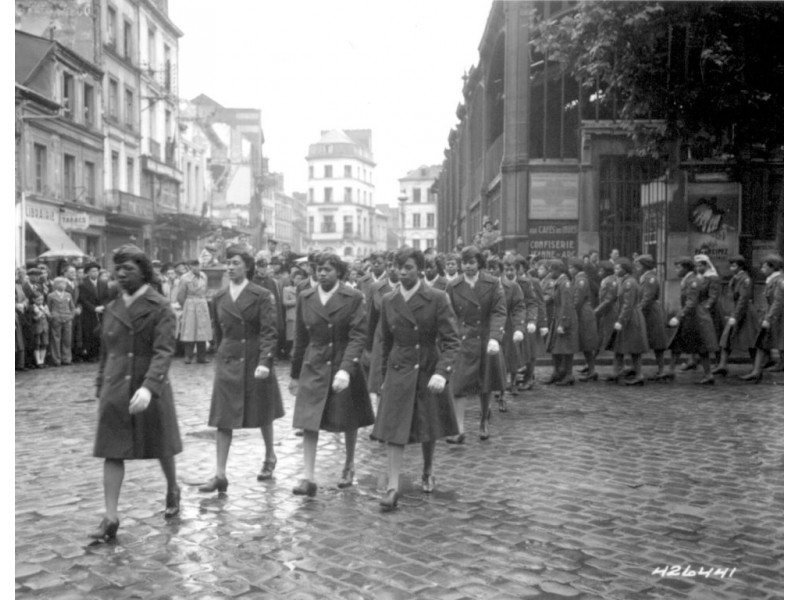

These Pictures show the “Six-Triple Eight” Central Postal Battalion. They were made up of about 1,000 women. They moved mountains of mail for millions of American service members and civilians that clogged warehouses in England and France. Their service to their country had been overlooked for years. They were the first all African American, all women unit to serve overseas during World War II.

She was Alberta Martin. She tried to enlist in the Army Nurse Corps. In autobiographical notes, she wrote that her application was denied because there was a quota for black nurses. In March 1945, she finally received a commission as a lieutenant and was one of 20 black nurses to serve in an integrated unit in Fort Meade, Maryland.
Bessie Stringfield was a legendary woman. She is known as the “Motorcycle Queen of Miami”. She was the first Jamaican-American woman to ride across America solo. At the age of 16 Stringfield taught herself to ride her first motorcycle, a 1928 Indian Scout. In 1930, at the age of 19, she commenced traveling across the United States. She made seven more long-distance trips in the US, and eventually rode through the 48 lower states, Europe, Brazil and Haiti. During World War II, she served one of the few motorcycle dispatch riders for the American military. During WWII Stringfield served as a civilian courier for the US Army, carrying documents between domestic army bases. She completed the rigorous training and rode her own blue 61 cubic inch Harley-Davidson. During the four years she worked for the Army, she crossed the United States eight times. She regularly encountered racism during this time, reportedly being deliberately knocked down by a white male in a pickup truck while traveling in the South. In the 1950's Stringfield moved to Miami, Florida. Some police harassed her since she was a black woman riding a motorcycle. Later, the police allowed her to ride her vehicle. She owned 27 of her own motorcycles. She broke down barriers for women and Jamaican American motorcyclists. In fact, Stringfield was inducted into the Motorcycle Hall of Fame. This award was bestowed by the American Motorcyclist Association (AMA) for “Superior Achievement by a Female Motorcyclist” is named in her honor. He lived from February 9, 1911 to February of 1993 in Opa Locka, Florida. She was born in Kingston, Jamaica.


Black women and men were about 6 percent of all employees in aircraft industries (whereas white women made up of 40 percent of all aircraft workers). Lena Horne, Dorothy Dandridge, Hazel Scott, and other African American women not only performed music and were in movies. They were active to oppose fascism during World War II. Clara Camille Carroll worked in Washington, D.C. in 1943. She was a black woman. She worked in a clerical job and she was from Cleveland, Ohio. By the 1950’s, she would be the first black American woman sailor based on Norfolk Naval base. She came into Howard University. There is a picture of Lt. Harriet Ida Pickens and Ens. Frances Willis from 1944. Black women worked in railroads, built planes, worked in the battlefield, and traveled across the world in fulfilling their occupations. Willa Beatrice Brown was the first black woman to earn a pilot’s license in America. A lifelong advocate for gender and racial equality in flight and in the military, Brown not only lobbied the U.S. government to integrate the U.S. Army Air Corp and include African Americans in the Civilian Pilot Training Program (CPTP), but also co-founded the Cornelius Coffey School of Aeronautics with Cornelius Coffey, which was the first private flight training academy in the United States owned and operated by African Americans. She trained hundreds of pilots, several of whom would go on to become Tuskegee Airmen. She was politically and socially active in Chicago. She taught many on how to fly. Pvt. Ruth L. James worked hard during World War II too. Frances Bates was an US Navy WAVE Apprentice Seawoman back in 1945. The Navy did not allow women of color until January 25, 1945. The first African-American woman sworn into the Navy was Phyllis Mae Dailey, a nurse and Columbia University student from New York. She was the first of only four African American women to serve in the Navy during WW2.


The Fights for Justice
Black Americans fought for justice during World War II. During the era of World War II, African Americans grew their political power. More African Americans moved into being Democrats than Republicans because of the administration of Franklin Delano Roosevelt’s claim to do something about discrimination in the military and involving society in general. FDR said that this New Deal would help Americans, but FDR had a mixed record on civil rights. Groups like the NAACP (or the National Association for the Advancement of Colored People), the National Urban League, and the National Negro Congress have called for equality and justice for black Americans. The Pittsburgh Courier was a newspaper of a large black readership. By 1938, it created the Committee on Participation of Negroes in the National Defense Program. Many people wanted to increase the amount of proportion of African Americans in the military. NAACP’s the Crisis magazine published articles about wanting democracy at home. During the 1940 presidential election, both parties courted the black vote. Incumbent President Franklin Delano Roosevelt was re-elected, partly because substantial numbers of black voters crossed previous party lines and voted for the Democratic Party candidate. During this time, great leaders like Ella Baker, Mary McLeod Bethune, Rosa Parks, Mary Church Terrell, and others fought for racial justice.
By 1941, civil rights activists A. Philip Randolph, A.J. Muste, and Bayard Rustin pushed Roosevelt to order fair employment for black people in the federal government. The activists threatened to march on Washington, D.C. in July 1941. Roosevelt didn’t want this to happen, because he felt that it would be a public relations disaster for his Presidency. A. Philip Randolph and others rightfully found it appalling that the Nazis were doing injustices overseas while black people were denied fundamental human rights in America. Back then, many black people were restricted from having skilled jobs in war production companies. Many of these companies refused to hire African Americans. The federal government at first refused to do anything about it. So, Randolph launched the MOWM or the March on Washington Movement. He wanted thousands of black people to march on Washington in 1941 to demand that Roosevelt issue an executive order to ban discrimination in the defense industry.
Walter White of the NAACP, Lester Granger of the Urban League, and other black leaders agreed with the plans for the march. Eleanor Roosevelt met with Randolph and White to try to convince them to call off the march. Randolph refused. He wanted action. So, FDR had a meeting with Randolph and other march leaders in June of 1941. Mayor Fiorello La Guardia of New York City worked with FDR and other to form a compromise agreement with Randolph. A. Philip Randolph agreed to call off the march and FDR issued the Executive Order 8802. This order banned employment discrimination in the defense industry and government. He or FDR also created a temporary Fair Employment Practices Committee to help ensure that defense manufacturers wouldn’t advance racial discrimination. It was the first action of the federal government to address racism nationwide since Reconstruction. Randolph called off the march and this was the first step in a long journey. This was one foundation of the civil rights movement of the 1950’s and the 1960’s.

CORE or the Congress of Racial Equality was created in 1942. Its founders were James Farmer, George Houser, and Bernice Fisher. It was created in Chicago and wanted to promote the philosophy of nonviolence in order for black people and all people to have equality, freedom, and justice. They would be involved in many efforts to fight for civil rights from the era of WWII to decades afterwards. The Port Chicago disaster caused another fight for justice. The Port Chicago disaster happened on July 17, 1944. It was an explosion of about 2,000 tons of ammunition. It was loaded onto ships by black Navy sailors under pressure from their white officers to hurry. It happened in Northern California and conditions were bad in that location. The explosion killed 320 military and civilian workers, most of them were black people who were killed. This led into the Port Chicago Mutiny, which called for safer working conditions in the location. This was the only case of a full military trial for mutiny in the history of the U.S. Navy against 50 African American sailors who refused to continue loading ammunition under the same dangerous conditions. The trial was observed by the then young lawyer Thurgood Marshall and ended in conviction of all of the defendants. The trial was immediately and later criticized for not abiding by the applicable laws on mutiny, and it became influential in the discussion of desegregation.
It is important to mention more information about Josephine Baker. She was born in St. Louis, Missouri and became an international entertainer. Yet, she was more than a musician and a dancer. She had a great deal of conscious about the world society. She dedicated her life to tolerance and fighting Jim Crow segregation in America. She lived long enough to see legal Jim Crow segregation to be gone by 1965 in America. She also heroically worked for the French Resistance. The French Resistance was fighting the Nazis and the evil pro-Nazi Vichy state during World War II. After the war, she was awarded the Croix de guerre by the French military, and was named a Chevalier of the Légion d'honneur by General Charles de Gaulle. She loved Paris as her 2nd love. She worked in the Civil Rights Movement and was a proponent of freedom, artistic creativity, and loyalty (or fidelity) to justice.
Rest in Power Sister Josephine Baker.


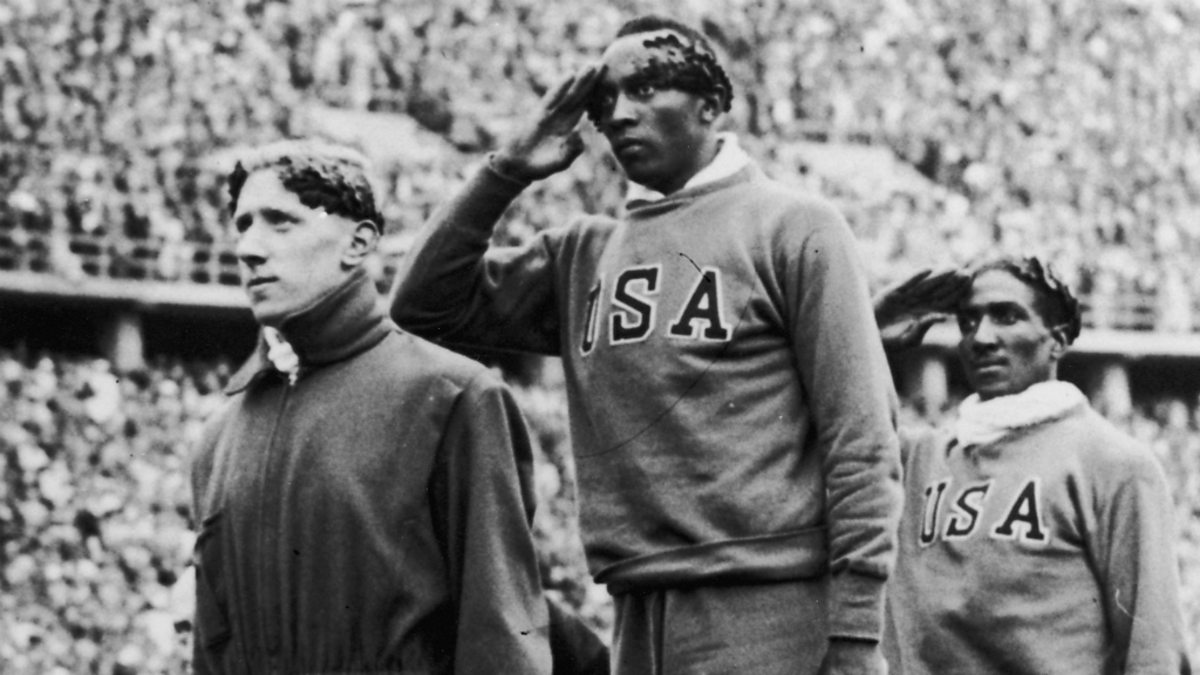
Black people and the Holocaust
There were black people in Germany back then. The Nazi Empire murdered many Afro-Germans. Even before WWI, Afro-Germans faced racism and discrimination in Germany. Many German racists didn’t want black people and biracial people in Germany to have equal rights. After WWI, many African colonial troops in the Rhineland had fathered children with German women. Newspapers in Germany called these children “Rhineland ba___.” That was wrong and evil. A very small number of biracial children were born (only about 400-600). There was a total black population of 20,000 to 25,000 human beings in Germany at the time. Hitler was a racist and he believed in the lie that black people were genetically inferior to whites (when Hitler wasn’t even a blue eyed, blonde Aryan). In Mein Kampf, he accused Jewish people of sending black people into the Rhine to make children in order for the white race to be harmed (while Jewish people would dominate Germany). He blamed France for this too. Of course, Hitler was wrong and a racist plus an anti-Semite. The Nazis used a eugenics program to sterilize biracial children born during occupation. Hitler and the Gestapo executed the sterilization of 500 children under this program including girls as young as 11. That was heinous. One biracial person named Hilarius Gilges (he grew up in Dusseldorf, Germany) was captured by SS officers in June of 1933. The SS stands for Schutzstaffel or the paramilitary and the surveillance organization formed by Hitler in 1925. Hilarius Gilges was tortured and murdered by them. Afro-Germans experienced discrimination in employment, welfare, and housing in Nazi Germany. Many of them were banned from having a higher education. There were Afro-German prisoners of war and African American soldiers who were prisoners of war too. Many of them were executed and many were not. Violence against black prisoners of war existed, which was against the Geneva Convention.
In prisoner of war camps, black soldiers were kept segregated from white prisoners, and generally experienced worse conditions than their white comrades, conditions that deteriorated further in the last days of the war. Roughly half of the French colonial prisoners of war did not survive captivity. Groups such as North Africans were sometimes treated as black, sometimes as white. Sister Valaida Snow was an African American woman who was a great musician. She was victim of Nazi imprisonment in 1941 while in Denmark. She was released in May 1942 after a prisoner exchange. She continued to make music afterwards. The story of the Liberian-German, Hans Massaquoi, who died at age 87 in 2013 is important to know about. He was a former managing editor of the American Ebony magazine and he wrote a memoir about his childhood in Nazi Germany. Black soldiers of the American, French, and British armies were worked to death on construction projects or died as a result of mistreatment in concentration or prisoner-of-war camps. Others were never even incarcerated, but were instead immediately killed by the SS or Gestapo. Other victims of Nazis included Jean Marcel Nicolas, Mahjub bin Adam Mohamed, the African American pilot from Portland, Oregon Lieutenant Darwin Nichols, Gert Schramm, and others. Some African American members of the U.S. armed forces liberated people. They saw the evil Nazi atrocities first hand. The all African American tank unit called the 761st Tank Battalion was under the command of General George Patton. The Battalion participated in the liberation of Gunskirchen or a subcamp of the Mauthausen concentration camp in May of 1945.
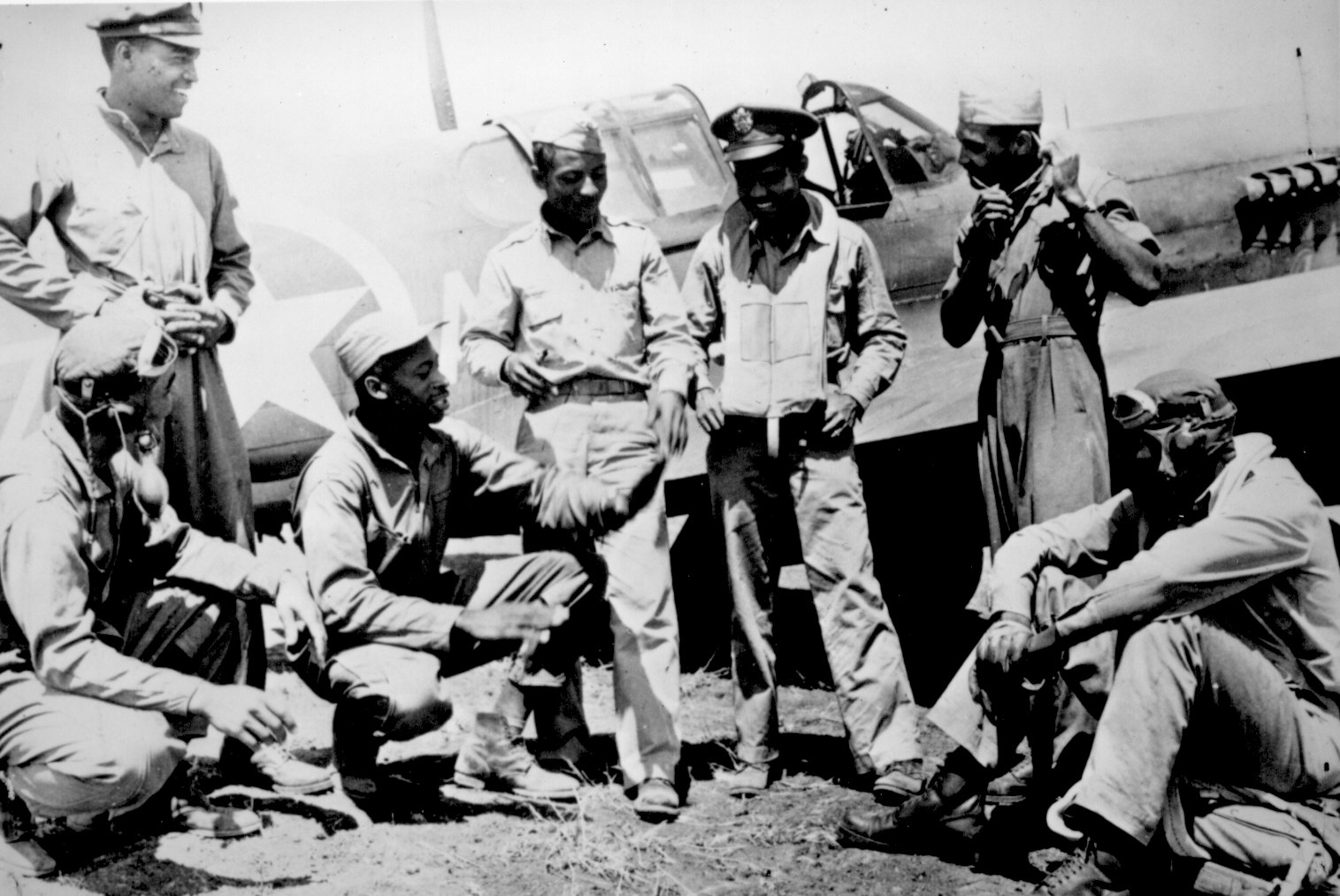

Conclusion
World War II was a long, deadly war. It involved the death of more people than any war in history. War is filled with bloodshed and destruction. African Americans were heavily involved in WWII as pilots, nurses, soldiers, tank operators, naval leaders, etc. They wanted the Axis Powers to be defeated. Also, they wanted racism to be defeated domestically in America. That is the precise meaning of the Double V movement. It wanted fascists defeated overseas and in America. The fascists in America promoted not only Jim Crow, but discrimination, racism, lynching, and other forms of oppression. Yet, black people never quit. We fought against injustices, stood up to the status quo, and defeated fascists in Europe at the same time. There were riots in Detroit and Chicago along with a rebellion in Harlem during the 1940’s. The activism of black people caused FDR to issue the first pro-civil rights executive order from a President since Reconstruction. World War II veterans weren’t just men. Many World War II veterans were black women too. Their service should be acknowledged, respected, and honored. After the War, black people still faced oppression and injustice. Many WWII veterans were murdered by racists. Many veterans continued to form an important part of the civil rights movement too in their activism. The Allied victory ended one chapter and started a new one in world history. America became the most powerful military nation on Earth. It became an international military and economic force overnight. It used capitalism to rebuilt markets in Europe and Japan. Also, the evil of Jim Crow would continue after WWII for the next 2 decades. The Civil Rights Movement in the modern sense would rise after the war. The next chapter of the African American History series will describe the modern Day Civil Rights Movement from 1954 to 1968.
Yes, Our Eyes are on the Prize.
By Timothy


Appendix A: The Second Great Migration and the Korean War
One of the greatest events in human history was the Second Great Migration of African Americans. It was the migration of more than five million African Americans. They traveled from the South to the North, the Midwest, and the West Coast. It happened from 1941 to 1970. It was much larger and was different from the first Great Migration (which lasted from ca. 1910-1940). The Second Great Migration started during the era of World War II. During the Second Great Migration, people traveled into Californian cities too like Los Angeles, Oakland, Richmond, and Long Beach. These places offered skilled jobs in the defense industry. In the Midwest, the West, and the North, discrimination still existed. Back then, many African Americans already had urban jobs in the South before they relocated. Many black workers were forced to work in segregated, low skilled jobs in many cities of the South. The Great Migration allowed African Americans to get highly skilled, well paid jobs at California shipyards. The Second Great Migration caused many African Americans to live in urban locations in a higher level. By the end of the Second Great Migration, 80 percent of black people lived in cities. Fifty-three percent remained in the Southern United States, while 40 percent lived in the Northeast and North Central states and 7 percent in the West. Many black people experienced dangerous work conditions too. There was a mention explosion at Port Chicago, California (near San Francisco). It killed over 200 black people in 1944. Later, some workers refused to work until conditions improved. Up to 50 were tried for mutiny and imprisoned. Many people migrated for a diversity of reasons.
Many wanted economic improvement in their own lives. They didn’t want economic deprivation. African American men and women wanted skilled jobs. They wanted to support their families. Northern employees hired African Americans from the South and whites from the South as a cheap labor force to replace the more costly European immigrant workers. Racial violence, political disenfranchisement, and educational opportunities were other reasons for the 2nd Great Migration too. In cities like San Francisco, Los Angeles, Chicago, etc. de facto segregation existed. De Facto segregation is segregation by policy not by law. Many black people were forced into low income housing, because of racial and economic discrimination. Freeways, urban renewal, and covenant policies in the Midwest, the West, and the North harmed black communities and advanced more segregation. Many families were overcrowded. White flight grew during the 1960’s too. White flight was driven in part by the process of blockbusting. White property owners, fearful of minority groups, sold their homes to real estate agents at a low price, often due to the tactics of the real estate companies themselves. Agents would then encourage that the vacant properties be bought by black families seeking respite from the overcrowded neighborhoods in which they were sequestered. When one black family moved in, the white neighbors would immediately sell their homes to the waiting real estate companies, who would in turn sell to more black people at a significant markup. Black people fought discriminatory housing laws too. The 1963 Rumford Fair Housing Act banned discrimination in housing in California. Yet, right wingers ended that law by the Proposition 14 (which harmed housing rights) in 1964. It would take the Supreme Court to declare Prop 14 unconstitutional. Some scholars believe that Prop 14 (which is an evil policy) contributed to the Watts rebellion of 1965. Many black Southerners brought their culture from food to music to areas across the West Coast, the North, and the Midwest in homogeneous communities. The Second Great Migration changed the culture of America permanently.
After World War II, the integration of the Armed Forces existed. On July 26, 1948, President Harry S. Truman signed Executive Order 9981. That order integrated the military and mandated equality of treatment and opportunity. It was a historic time. It made it illegal, per military law, to make a racist remark. It would be years later for the whole military to be desegregated. All black units were in the Korean War. The last all-black unit was disbanded by 1954. In 1950, Lieutenant Leon Gilbert of the still-segregated 24th Infantry Regiment was court martialed and sentenced to death for refusing to obey the orders of a white officer while serving in the Korean War. Gilbert maintained that the orders would have meant certain death for himself and the men in his command. The case led to worldwide protests and increased attention to segregation and racism in the U.S. military. Gilbert's sentence was commuted to twenty and later seventeen years of imprisonment; he served five years and was released. Harry Truman extended his executive order to schools and neighborhoods as well as military units. Fifteen years after the Executive Order, Secretary of Defense Robert McNamara issued Department of Defense Directive 5120.36. "Every military commander", the Directive mandates, "has the responsibility to oppose discriminatory practices affecting his men and their dependents and to foster equal opportunity for them, not only in areas under his immediate control, but also in nearby communities where they may gather in off-duty hours." While the directive was issued in 1963, it was not until 1967 that the first non-military establishment was declared off-limits. In 1970 the requirement that commanding officers first obtain permission from the Secretary of Defense was lifted, and areas were allowed to be declared housing areas off limits to military personnel by their commanding officer. The end of military segregation caused the increase of representation of African Americans in the military. Now, we have an all-volunteer army.
The Korean War has been forgotten by many, but we will never forget. It was a war about a dispute between North and South Korea over philosophies and territories. North Korea was a Communist state while South Korea was a capitalist state. North Korea received military aid from the Soviet Union and China while South Korea received military aid from America and its allies. The war was short, but extremely bloody. Tons of people lost their lives among both sides. African American soldiers were heavily involved in the war. Jesse L. Brown was the U.S. Navy’s first black aviator in October 1948. He was killed when his plane was shot down during the Battle of Chosin Reservoir in North Korea.
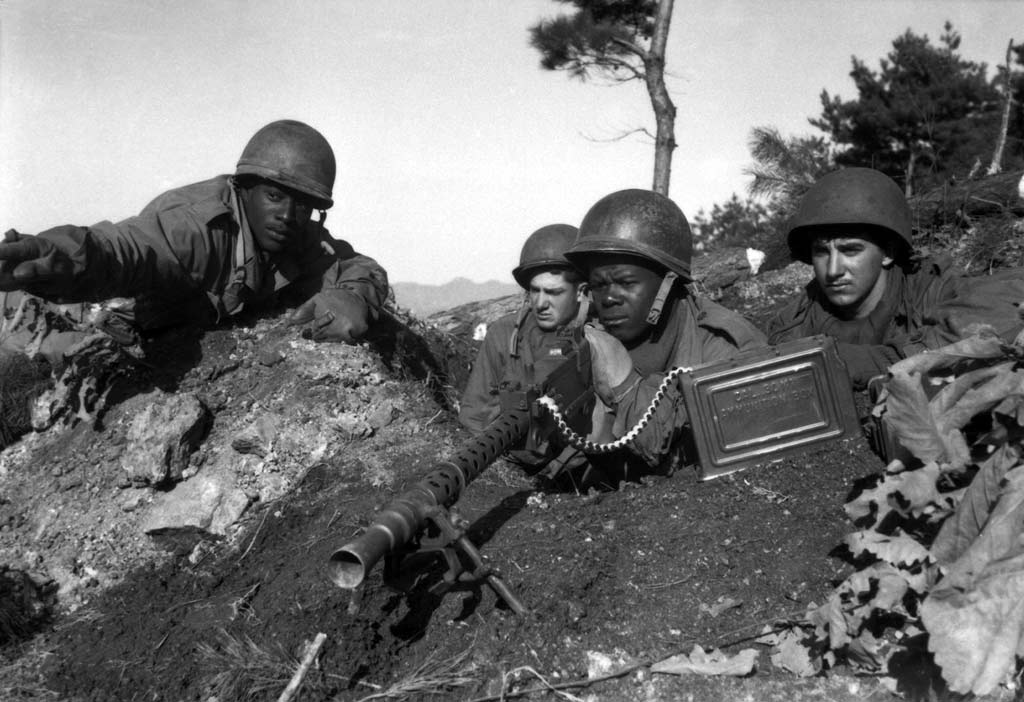

He was unable to parachute from his crippled F4U Corsair and crash-landed unsuccessfully. His injuries and damage to his aircraft prevented him from leaving the plane. A white squadron mate, Thomas Hudner, crash-landed his F4U Corsair near Brown and attempted to extricate Brown but could not and Brown died of his injuries. Hudner was awarded the Medal of Honor for his efforts. The U.S. Navy honored Jesse Brown by naming a frigate after him—the USS Jesse L. Brown (FF-1089), Two enlisted men from the 24th Infantry Regiment (still a segregated unit), Cornelius H. Charlton and William Thompson, posthumously received the Medal of Honor for actions during the war. African Americans served in all combat and combat service elements during the war. By 1950, about 100,000 African Americans were on active duty in the U.S. Armed Forces. That was about 8 percent of the total manpower. By October 1951, the all black 24th Infantry Regiment was disbanded. It was formed in 1869 and it served in the Spanish American War, WWI, WWII, and during the beginning of the Korean War. The recapturing of Yech’on was done heavily by a battalion combat team commanded by Lieutenant Colonel Samuel Pierce Jr. and it was made up of 3 infantry companies and an engineer company. This took place on July 21, 1950. Captain Charles Bussey was the commander of the engineer company during that operation and he was awarded the Silver Star for preventing a flanking operation by a North Korean battalion during the battle. Second Lieutenant Frank E. Peterson Jr., was the first black Marine Corps pilot. Peterson flew 64 combat missions before the war ended. He earned the Distinguished Flying Cross and six Air Medals in the final months of the Korean War. In 1950, the Air Force had 25 black pilots in integrated fighter squadrons led by Captain Daniel "Chappie" James Jr., who was assigned to the 36th Squadron, 5th Air Force. Captain James was an exceptional fighter pilot who often flew his F-86 Sabre jet on dangerous, unarmed reconnaissance missions behind enemy lines -- a task reserved for a select group of the most able and trusted flyers. James flew 101 combat missions in Korea and earned the Distinguished Flying Cross before being reassigned stateside. In July 1951, he became the first African-American in the Air Force to command a fighter squadron.
More than 600,000 African Americans served in the armed forces during the Korean War. More than 5,000 black people died in combat. There were African American POWs in the Korean War too. Black women were involved in the Korean War too. The WACs started to integrate training and living in April of 1950. By January 6, 1948, Ensign Edith De Voe was sworn into the Regular Navy Nurse Corps and in March, First Lieutennant Nancy C. Leftenant was a part of the Regular Army Nurse Corps. She was part of the corps’ first black members. The African American WAC detachment at Fort Lewis, Washington was mostly black all over the Korean War. The detachment commander was Mary Teague Smith. She fought discrimination about white women going up the ranks faster than black women. She was reassigned to Japan by 1952. By 1952, the Secretary of the Army did something. They told a congressional committee of the armed services of wanting African American women to comprise only 20 percent of the unit. Army Nurse Captain Yorke in 1952 was a black woman who was stationed in Korea for the whole Korean War. She treated the injured. African American women in the military fought both racism and sexism in the service.

In 1952, 2 African American military women fought to end Jim Crow policies in interstate transportation. One was Sarah Keys Evans. Sarah Evans refused to go to the back of the bus was while in North Carolina. She was arrested, jailed overnight, and fiend. She fought in the courts. Dovey Johnson Roundtree (she was in the Women’s Auxiliary Army Corps or WAAC via the advice of her mentor Mary McLeod Bethune. Bethune fought of the desegregation of the military) was a former WAC officer. She was an attorney in Washington D.C. too. She took on the Keys case. Roundtree continued to file suit and by 1955, the 11 man ICC Commission agreed with Keys. It ended Jim Crow policy on all interstate transportation. Keys experienced unjust discrimination and racism. She won her battle. Black women were in the Air Force by 1949. One person in the Air Force was Helen Gentry. Women were allowed into the Navy by 1944. Freddie Mae Hopson was enlisted in the Navy in early 1952. The first African American women in the Marines were Annie Graham and Ann Lamb in 1949. They volunteered. Annie Grimes was the third person to enlist in 1950. The African American involvement in the Korean War was very extensive.
By Timothy
P.S. The following links gives you an opportunity to assist an upcoming documentary about African American women involvement in WWII.
http://invisiblewarriorsfilm.com/
http://www.ebony.com/entertainment-culture/invisible-warriors-african-american-women-in-world-war-ii-981#axzz4wHR4Aknt
https://www.scribd.com/document/354466703/The-African-American-Story-Part-5
https://drive.google.com/file/d/0B9ao63AKn_rLOXA3cEs4NDhIZWc/view
No comments:
Post a Comment